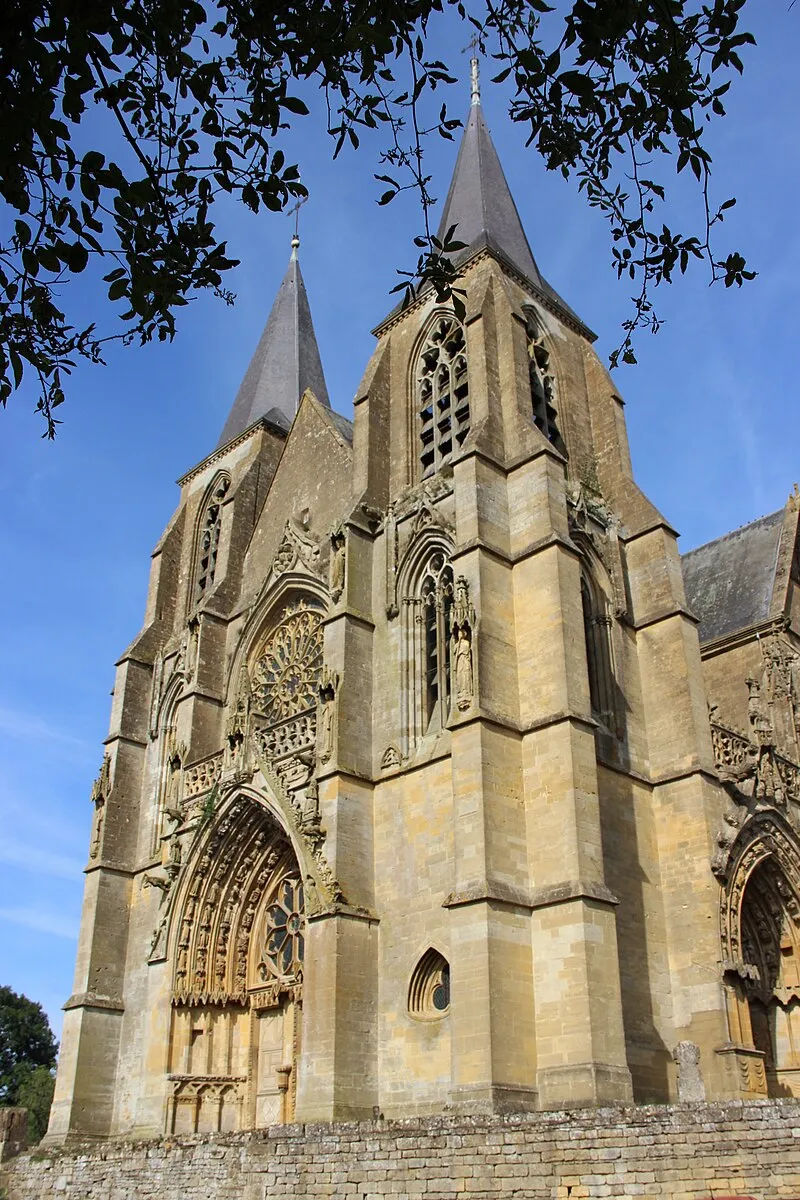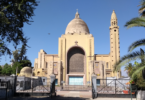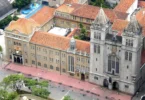Introduction

The Basilica of Our Lady of Avioth is a minor Catholic basilica in the Gothic style built in the 14th century and located in the former county of Chiny (today in the north of the French department of Meuse ), in the French commune of Avioth .
It has been listed as a historical monument since the first list in 1840. Given its size, the church is also called “The Cathedral of the Fields”. The Avioth Basilica houses the recumbent statue of the Countess of Breux .

Initially a simple hamlet, the village of Avioth owes its development to the miraculous discovery of a wooden statue of the Virgin and Child in the 12th century . A pilgrimage quickly developed there, and the ecclesiastical and feudal authorities quickly supported the construction of a church worthy of this pilgrimage: the great church of Avioth was born!
The church of Notre-Dame d’Avioth enjoyed the privilege of being a very popular ” sanctuary of respite “. The pilgrimage of Notre-Dame d’Avioth has taken place since the 12th century and still brings together today, theJuly 16, many faithful. Bernard of Clairvaux is said to have sung the Salve Regina there for the first time . Pope John Paul II elevated the building to the rank of minor basilica in 1993.
Our Lady of Avioth is one of the rare black virgins in the North-East of France. Carbon-14 dating of the lime statue of Our Lady of Avioth shows that the wood was cut around the year 1095 and confirms the tradition that the statue was discovered in the 12th century.

The Great Church of Avioth
Foundation
In the 12th century , the accidental discovery of a statue of the Virgin and Child and the miraculous return to its location led to the creation of a first oratory . A small wooden chapel was probably built shortly afterwards to house the statue, but quickly became insufficient in the face of popular fervour. A first Romanesque church was probably built in stone, at least some pillars of the choir seem to date from this period. The village was liberated in 1223 and quickly saw an economic boom alongside the pilgrimage. It thus seems that the construction of a vast Gothic nave followed shortly after, probably at the end of the 13th century.
Building
Few documents allow us to date the current church, the construction of which seems to have begun with the choir in a typical Radiant style of the end of the 13th century . The church stands on a vast terrace surrounded by an enclosure that is still clearly visible and dominated by the receiver.
The plan is of the basilica type with two levels and an ambulatory . The general style seems to borrow from many schools, Lorraine for the elevations (double elevation – non-projecting transepts), Champenoise for the ambulatory and the glass portal of the western facade, in the Reims style. The western facade, which dates from the 14th century , presents an impressive profusion of sculptures (spared after the French Revolution ) and clearly takes up the elevation of the nearby abbey church of Mouzon .
The north side has been the least modified, a small portal opening onto the transept and surmounted by a large bay in the Toulois style. In the first bay of the choir was added in the 15th century an elegant small two-storey building whose function is unknown and which remains totally invisible from the inside. The side portal, dating from the 15th century , became the main portal, a profusion of sculptures presents in its center a sculpted tympanum evoking the life of the Virgin Mary . At the end of the 15th century , a vast flamboyant chapel was added in the extension of the south transept, it was significantly modified and decorated again during the Renaissance , particularly in its decoration.
The 18th century established a vast staircase providing direct access to the terrace in front of the western portal. Few statues were removed during the French Revolution and some less visible restorations were carried out in the 19th century by Émile Boeswillwald .
Interior
Although the entrance is lateral, the two-level elevation gives a beautiful impression of height under the vault, the side aisles are not very high. The first two bays of the nave are separated from the third by two steps due to the difference in level. The large bay of the transept, not protruding, brings in beautiful light, as does the new chapel located in the extension of the south transept. The choir, two bays deep, is surrounded by a beautiful stone enclosure, openwork and surmounted by an impressive Eucharistic cupboard whose shape seems to have inspired that of the exterior Recevresse. An ambulatory opening onto chapels completes the volume of the basilica. The gallery organ is by Boizard Nicolas (organ builder).
The "Receiver"

“La Recevresse” is a unique monument in the world and its life-size reproduction is in the Museum of French Monuments at the Cité de l’Architecture et du Patrimoine in Paris.
This flamboyant Gothic masterpiece was probably built on the site of the discovery of the miraculous statue “on its thorn bush”. It replaced a first, more modest oratory. At the beginning of the 14th century , when the statue of Our Lady of Avioth was able to enter its church, another statue of the Virgin took its place to receive, in her name, the offerings of the pilgrims. This statue was called: the Virgin Recevresse. Over time, the name Recevresse was given to the monument. Thus, for eight centuries, the basilica of Avioth has been built and maintained thanks to donations and offerings. This is still the case today. Thanks to the generosity of the members of the Association of Friends of the Basilica of Avioth and the many pilgrims who come to pray to Our Lady of Avioth, the town can regularly undertake work and obtain help from the General Council of the Meuse and the Regional Directorate of Cultural Affairs of Lorraine. The handcuffs above the statue were placed there by prisoners as a sign of gratitude to Our Lady of Avioth for their deliverance. The coat of arms on the wall is that of Gilles de Rodemack, provost of Montmédy and governor of Luxembourg at the beginning of the 15th century .
La Recevresse was restored by Émile Boeswillwald from 1844 to 1846. The stained glass windows of the Saint- Jean chapel are by master glassmaker Jean-Jacques Grüber (1930).
Feast Day
Feast day: September 8
The Annual Feast day of Basilica of Our Lady of Avioth, is celebrated on September 8 each year.
Church Mass Timing
Yet to Update
Church Opening Time:
Monday : 7:30 am – 6:30 pm
Tuesday : 7:30 am – 6:30 pm
Wednesday : 7:30 am – 6:30 pm
Thursday : 7:30 am – 6:30 pm
Friday : 7:30 am – 6:30 pm
Saturday : 7:30 am – 6:30 pm
Sunday : 7:30 am – 6:30 pm
Contact Info
Address :
5 Rue de l’Abbé Delhotel, 55600 Avioth, France
Phone : +33329867761
Accommodations
Connectivities
Airway
Basilique Notre-Dame d’Avioth, 5 Rue de l’Abbé Delhotel, 55600 Avioth, France to Lorraine Airport (Nancy/Metz), Rte de Vigny, 57420 Goin, France is , 1 hr 37 min (125.2 km) via A30 away from Basilica.
Railway
Basilique Notre-Dame d’Avioth, 5 Rue de l’Abbé Delhotel, 55600 Avioth, France to Metz, 1 Pl. du Général de Gaulle, 57000 Metz, France 1 hr 21 min (99.3 km) via A30 away from Basilica .








